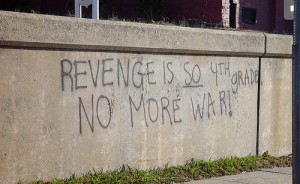 This is the third and last posts I wrote for The Secure Times, the blog of the Privacy and Information Security Committee of the American Bar Association Section of Antitrust Law.
This is the third and last posts I wrote for The Secure Times, the blog of the Privacy and Information Security Committee of the American Bar Association Section of Antitrust Law.
I was sitting at an airport café a few weeks ago, and witnessed a group of friends having fun, speaking and laughing together around a table. Next to them was a middle-aged business man wearing Google Glass.
One of the members of the group spotted the glasses, and started a conversation with their wearer. The business man obliged, saying he liked them very much, and then said: Oh, and by the way, I just took a picture of you!
The mood of the group subtly changed. They politely ended the conversation and then, very slowly, as not to be rude, all turned their back to the business man.
I had just witnessed a Google Glass breach of etiquette, and for what is worth, it did not seem that the culprit was unaware of it.
Etiquette for a Wearable Computers World
Do we need new rules to live in a society where the person next from us on line at the supermarket counter, or worse, behind us at the pharmacy while we pick up drugs, may be able to take a photograph of us, or to film us, without us even noticing it?
Google itself seems to believe we do, as it recently released a guide for ‘Google Glass Explorers,’ people who have been given the opportunity to test Google Glass, which are still not available for sale.
Well, it seems that the business man I witnessed at the airport broke one of the Do’s of the guide: ‘Ask for permission.’ While this seems just common sense if one if taking a photograph, how could we possibly ask for permission to film a crowd? Should we ask every single person for permission?
Google Glass and Law Enforcement
Knowing the answer to this question may be a matter of personal safety. A woman claimed this week that she was attacked and robbed in a bar at San Francisco while wearing Google Glass, and, according to her, it was because she was wearing Google Glass.
It seems that she was later able to retrieve her Google Glass. Interestingly, its camera had apparently recorded the incident, showing a man ripping the glasses off her face. Could the recoding be used as evidence?
Indeed, Google Glass may be used by law enforcement officials in the near future. New York’s finest, the NY Police Department, is experimenting with two pairs of Google Glass, to find out whether they could be used for police work. That could raise some interesting fourth amendment issues.
On the other hand, Google Glass may become the pet peeve of police officers in charge of enforcing road security.
A woman got a ticket in San Diego last October, for speeding, but also for wearing Google Glass, as 27602(a) of the California Vehicle Code forbids driving a motor vehicle if “a television receiver, a video monitor, or a television or video screen, or any other similar means of visually displaying a television broadcast or video signal that produces entertainment or business applications, is operating and is located in the motor vehicle at a point forward of the back of the driver’s seat, or is operating and the monitor, screen, or display is visible to the driver while driving the motor vehicle.”
The case was later dismissed, as the judge did not find enough evidence to prove beyond a reasonable doubt that Google Glass was switched on while its wearer was driving.
Is it safe for car drivers to wear Google Glass while driving? It may be banned soon by legislators, just as texting and using a telephone while driving is forbidden in most states. Some states, such as Illinois, have already introduced bills to that effect. It remains to be seen if they will be enacted; Reuters reported this week that Google is lobbying to stop these bills from becoming law.
Facial Recognition and Google Glass
Even though Google has not (yet) developed a facial recognition app for Google Glass, another company, NameTag has done so. It would allow Google Glass wearers to pick a suitable date among a crowd of strangers, by scanning social media information of people around them. That triggered concerns from Senator Al Franken (D-Minnesota), who sent aletter on February 5th to the President of NameTag, expressing his “deep concerns” about the new app and urging him to delay its launch “until best practices for facial recognition technology are established.”
It is not the first time legislators are expressing concerns over the privacy issues involved in Google Glass, and it probably won’t be the last.
Source: The Secure Times
Image is lunette courtesy of Flickr user thierry ben abed pursuant to a CC BY-ND 2.0 license.












